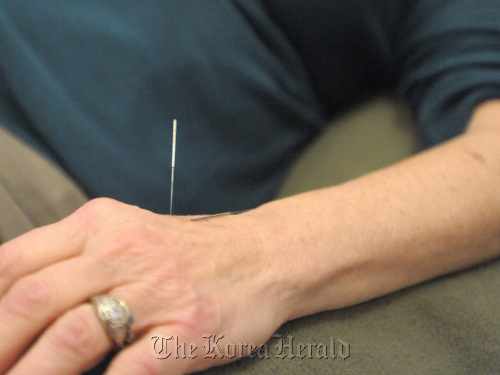Constant headaches and migraines had Diana Schulin considering acupuncture, but she found herself tensing at the thought of sitting alone in a room while being poked by a dozen needles.
She finally took the plunge, and she’s glad she did. The needles remain. But at least now she has company.
The health care information worker is among a small but growing number of people experiencing the ancient Asian treatment in a group. Some come for the lower cost, while some, like Schulin, are drawn by the camaraderie.
“Because the other people are there, you feel relaxed, said Schulin, a Baltimore resident. “It makes you feel more comfortable. Traditional acupuncture clinics are a little more tense. You are there by yourself. When you are in the room with other people, there is a sense of calm.”
Acupuncture ― the practice of inserting needles in specific spots of the human body ― is nothing new. But the concept of community acupuncture is relatively rare in this country. There are about 200 community acupuncture clinics in the U.S.; a majority is found along the coasts and in larger cities, according to Fred Wolfson, who opened Acupuncture for All in Baltimore’s Mount Washington neighborhood nine weeks ago after working at a similar practice in Frederick, Md.
 |
Fred Wolfson, owner of “Acupuncture For All” treats several patients at a time in a peaceful, communal room, which keeps the costs down from what a normal acupuncture procedure costs. (Gene Sweeney Jr./Baltimore Sun/MCT) |
Wolfson said the concept is modeled after group clinics in Asia, which have historically been low-cost.
Community acupuncture patients say they are drawn to the clinics because of the combination of low cost, accessibility, and the community concept.
Patients at clinics such as Wolfson’s pay between $20 to $40 a treatment. (Traditional practices charge up to $90 per visit.) Wolfson goes an extra step and offers a sliding scale. He never challenges the amount of money he receives. Payments are deposited in a drop box in the clinic.
“Patients pay what they can afford,” he said. “Everyone’s financial situation is different. There are people who ask if they can pay below that $20 fee because of their financial situation. That is fine. I don’t turn anyone away.”
Low cost is the biggest draw of community acupuncture businesses, according to Karen Jackson-Williams, a licensed acupuncturist who works at Honey-Bee Free Acupuncture in Greenbelt, Md., and Tai Sophia Institute in Laurel, Md.
Jackson-Williams, who has been following the community acupuncture model for the past two years, said lower cost helps expose more people to the treatment.
“If anything, it would be a benefit to a traditional practitioner,” she said. “People get to have a good first experience at a reduced price. Then they have the opportunity to later use a private practitioner if they want.”
The lower price also allows patients to receive frequent treatments, which maximizes the benefits of acupuncture, Wolfson said.
“Because of the low cost, patients are unable to do the follow-up treatment,” Wolfson said. “That is an important piece of community acupuncture. It is not about just getting enough money for an acupuncture treatment. This model allows people to go through a whole course of treatment. They are able to see if acupuncture is a modality for them.”
And community acupuncturists are able to treat a larger number of patients in a shorter amount of time.
At most community clinics, each visit typically lasts about an hour. An intake questionnaire is completed so that the acupuncturist can individualize the proper plan for each patient. After customers roll up their sleeves and remove their shoes, they are ready for the treatment.
“The needles stay in on average 45 minutes,” Wolfson said. “The nice thing about the clinic is that people who want to stay longer can stay. But most people feel done after 45 minutes.”
Despite Acupuncture for All’s high-volume mission, the clinic is surprisingly quiet.
The gurgle from a water fountain meshes with relaxing music playing overhead. Seven reclining seats are arranged in a circular fashion. The walls are painted with a cobalt blue and adorned with framed pictures of exotic locations. A large oriental rug in the center of the room pays homage to the technique’s origins. The dimmed lights give the room a relaxed feel.
“It’s like being in your living room,” Schulin said.
Wolfson encourages a tranquil environment.
“A majority of people fall asleep,” Wolfson said. “We may whisper a little bit as I am putting in the needles. But generally the treatment room is very quiet.”
Tuesday night, there was a constantly flow of patients, including Lynn Hunobice, an activity director for a local retirement community, who visits the clinic at least once a week.
Hunobice sought out acupuncture because she needed a source of relief from arthritis and the daily stress involved in her job.
“I needed to bring a balance to life,” she said. “I have a very intense job. I can get overwhelmed with it.”
Wolfson stresses that community acupuncture and acupuncture in general is not for everyone.
“Acupuncture is not going to be the treatment that helps everyone,” he said. “If they can’t do a consistent course of treatment and the treatments become sporadic, then they can’t decide if this is the treatment for them or not.”
By John-John Williams IV
(The Baltimore Sun)
(McClatchy-Tribune Information Services)








